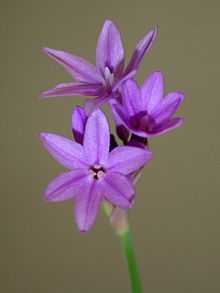Tulbaghia violacea
| Tulbaghia violacea | |
|---|---|
.jpg) | |
| Scientific classification | |
| Kingdom: | Plantae |
| Clade: | Angiosperms |
| Clade: | Monocots |
| Order: | Asparagales |
| Family: | Amaryllidaceae |
| Subfamily: | Allioideae |
| Genus: | Tulbaghia |
| Species: | T. violacea |
| Binomial name | |
| Tulbaghia violacea Harv. | |

Tulbaghia violacea (society garlic, pink agapanthus) is a species of flowering plant in the onion family Alliaceae, indigenous to southern Africa. Growing to 60 cm (24 in) tall by 25 cm (10 in) wide, it is a clump-forming perennial with narrow leaves and large clusters of fragrant, violet flowers from midsummer to autumn (fall).[1]
When grown as an ornamental, this plant requires some protection from winter frosts. It has gained the Royal Horticultural Society's Award of Garden Merit.[2]
T. violacea is used locally as a herbal remedy/medicine to treat several ailments. Recently it was demonstrated to have androgenic[3] and anti-cancer[4] properties in vitro.
T. violacea exhibited antithrombotic activities which were higher than those found in garlic.[5]
References
- ↑ RHS A-Z encyclopedia of garden plants. United Kingdom: Dorling Kindersley. 2008. p. 1136. ISBN 1405332964.
- ↑ "RHS Plant Selector - Tulbaghia violacea". Retrieved 07 June 2013.
- ↑ Mozaffar Ebrahim & Edmund John Pool (2010). "The effect of Tulbaghia violacea extracts on testosterone secretion by testicular cell cultures". Journal of Ethnopharmacology 132 (1): 359–361. doi:10.1016/j.jep.2010.08.018. PMID 20723589.
- ↑ S. Thamburan, F. February, M. Meyer, J. Rees & Q. Johnson (2009). "Tulbaghia alliacea: A potential anti-cancer phytotherapy". Planta Medica 75 (9): SL35. doi:10.1055/s-0029-1234290.
- ↑ Lelethu Bungu, Maryna van de Venter & Carminita Frost (2008). "Evidence for an in vitro anticoagulant and antithrombotic activity in Tulbaghia violacea" (PDF). African Journal of Biotechnology 7 (6): 681–688.
External links
| Wikispecies has information related to: Tulbaghia violacea |
| Wikimedia Commons has media related to Tulbaghia violacea. |